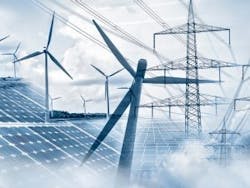A new European project, TIGON, will develop technology and demonstrate how direct current (DC) microgrids can help the European Union’s (EU) electricity grids become greener, more efficient and resilient.
By gopixa/Shutterstock.com
The project involves 15 partners from eight different European Member States. The EU’s Horizon 2020 research and innovation program is providing part funding for the $9.4 million (US) project, which fits into the EU’s wider plans for building a low carbon and climate resilient future.
Most grids operate on alternating current (AC), but the attractiveness of DC is increasing. This is due to the proliferation of renewable energy, most of which generate a DC output, as well as the increase in DC loads from modern electrical equipment like laptops, electric vehicles, and LED lighting.
As such, project TIGON aims to demonstrate deployment of DC-based grid architectures within the current energy system, with the ability to provide ancillary services to the main network.
“In a classic approach, the electric grid is AC because it is easier to change the voltage level with power transformers; this is a useful feature,” Jesús Muñoz, TIGON project coordinator and power electronics engineer at Spanish research center Fundación CIRCE, told Microgrid Knowledge.
“If you want to connect to DC devices, it is cumbersome because you have to convert firstly to AC and afterwards back to DC.”
Developing direct current microgrid solutions
Over the four years of the project, the international team will develop new software and hardware solutions to enable local DC infrastructure to better integrate renewables and store electricity. Two microgrids in France and Spain will be used to demonstrate the solutions, with the findings subsequently applied at two sites in Finland and Bulgaria to test replicability.
The French and Spanish demonstration microgrids will integrate solar power, energy storage, and DC loads using a range of technologies.
“In both demo sites, we have a medium voltage DC line, connected to a solid-state transformer that works as the point of common coupling to the external AC grid,” Muñoz said.
He also explained that the medium voltage DC lines are connected to low voltage AC and DC lines through rectifiers and DC/DC converters.
“We have a mixture to explore all alternatives. One of the objectives of the project is to develop a new energy management systems to control the grid.”
These solutions will be complemented by development of WAMPAC systems, Wide Area of Monitoring, Protection and Control, to ensure stability and security of the grids.
Track news about direct current microgrids. Subscribe to the free Microgrid Knowledge newsletter.
